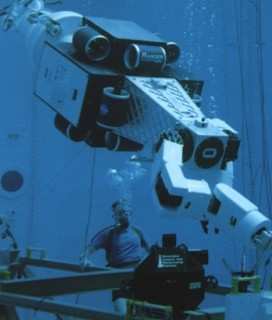NASA: It Could Happen
 Edward Weiler, NASA associate
administrator for space science, puts it like this: "I'm not saying
it's a done deal. A lot of water needs to go under the bridge, but
it's looking a lot better than it did two months ago."
Edward Weiler, NASA associate
administrator for space science, puts it like this: "I'm not saying
it's a done deal. A lot of water needs to go under the bridge, but
it's looking a lot better than it did two months ago."
He's talking about the possibility of a rescue mission to the
Hubble Space Telescope -- one that wouldn't involve the space
shuttles or human beings, for that matter. But by his statement, it
seems pretty clear that NASA is quickly warming up to the idea of a
robotic mission to the space telescope.
Two months ago, NASA's Goddard Space Flight Center asked
contractors for proposals on sending a robot to Hubble to replace
the gyros and batteries. "There was no one silver bullet, no one
right answer," Weiler was quoted by the Washington Post as saying.
"I was skeptical... but... the technologies we need are out
there."
NASA got 26 proposals in return. They include:

Developed by NASA's Johnson Space Center in Houston (TX), this
robot has five fingers, looks rather human and is designed to
replace humans on space walks.

The University of Maryland's 25-foot tall robot can stand on a
platform tied to the Hubble and reach everywhere it needs to reach
to replace the Hubble's batteries and gyros.

Short for the Canadian Space Agency's Special Purpose Dextrous
Manipulator, this robot has arms that reach 10-feet from a sort of
torso. Remember, the Canadians designed the robot arms on the space
shuttles and the International Space Station -- these guys have
experience where experience is hard to come by. Dextre, however,
has never been built. It was supposed to be assembled aboard the
ISS next year. The Columbia's demise, however, put those plans on
hold.
 "I suspect they're going to pick and
choose to come up with a synthesis that's better than any of the
individual plans," aerospace engineer David Akin, told the Post. He
leads the Ranger project at the University of Maryland's Space
Systems Laboratory. "It's the same with every mission -- the
devil's in the details."
"I suspect they're going to pick and
choose to come up with a synthesis that's better than any of the
individual plans," aerospace engineer David Akin, told the Post. He
leads the Ranger project at the University of Maryland's Space
Systems Laboratory. "It's the same with every mission -- the
devil's in the details."
As ANN reported earlier, time is of the essence. NASA says
there's a 50-percent chance Hubble will have just one functioning
gyro by the middle of 2006. There are six on board and the vehicle
needs three to maintain the attitude necessary for the telescope to
remain useful.
Space shuttles have been dispatched to fix and upgrade the space
telescope. All had their risks, but then, all had humans to judge
the risks and take the necessary chances.
You can't underestimate the complexity and the dangers," former
astronaut Jeffrey A. Hoffman told the Post. Hoffman is an aerospace
engineer at the Massachusetts Institute of Technology who made
three space walks to repair Hubble in 1993. "Suppose you open a
door but can't put in the new instrument. Now you've got a light
leak, and you've lost your telescope."
The drop-dead date for servicing the Hubble is the last quarter
of 2007. Beyond that, NASA doesn't think the vehicle's batteries
will hold a charge. If that becomes the case before NASA can mount
a rescue mission -- manned or robotic -- Hubble is a goner. And
then there's the question of where it might land.
 Airborne-Flight Training 05.09.24: ERAU at AIAA, LIFT Diamond Buy, Epic A&P
Airborne-Flight Training 05.09.24: ERAU at AIAA, LIFT Diamond Buy, Epic A&P ANN's Daily Aero-Term (05.07.24): Hazardous Weather Information
ANN's Daily Aero-Term (05.07.24): Hazardous Weather Information Aero-News: Quote of the Day (05.07.24)
Aero-News: Quote of the Day (05.07.24) NTSB Final Report: Cessna 150
NTSB Final Report: Cessna 150 Aero-News: Quote of the Day (05.08.24)
Aero-News: Quote of the Day (05.08.24)







